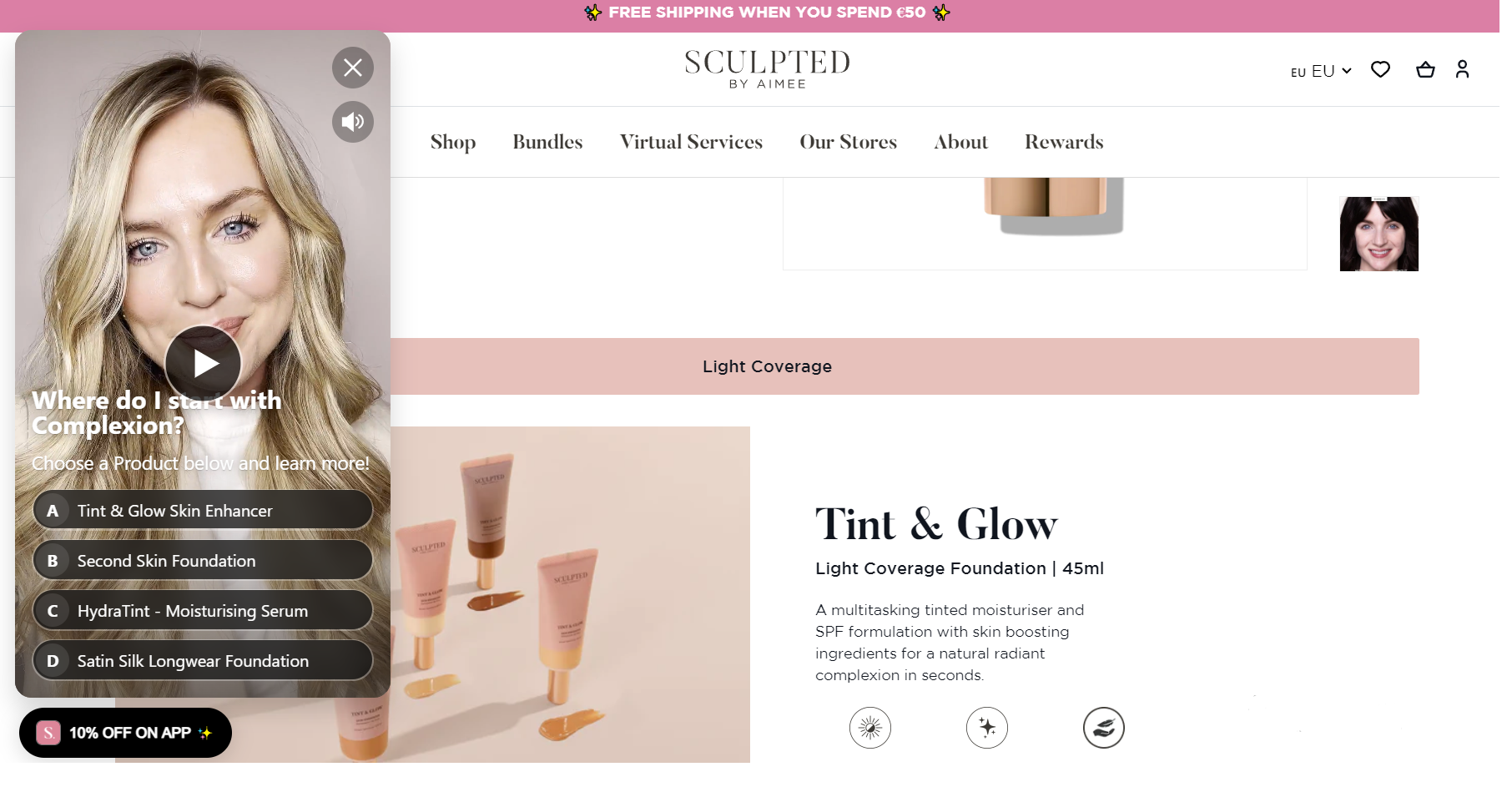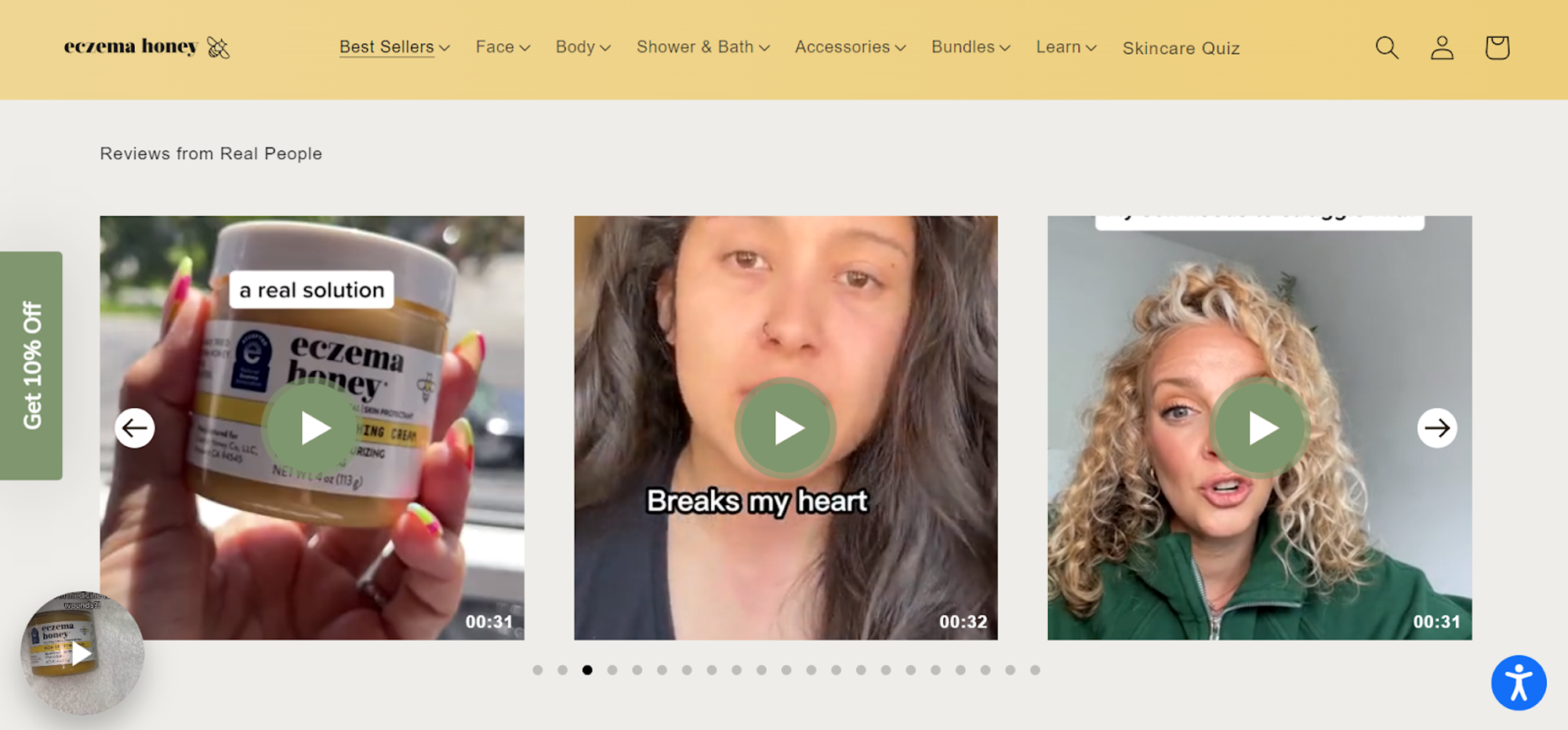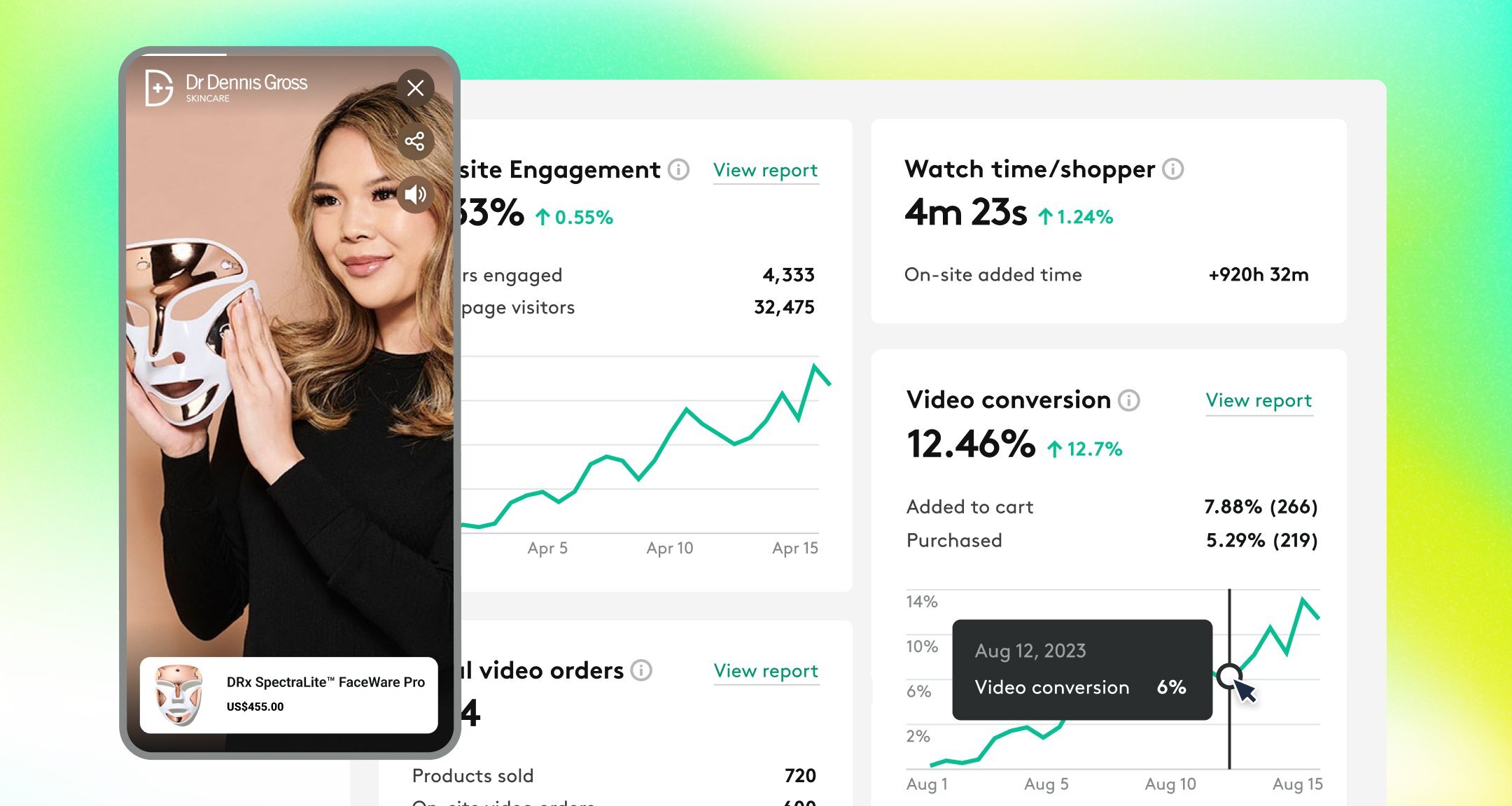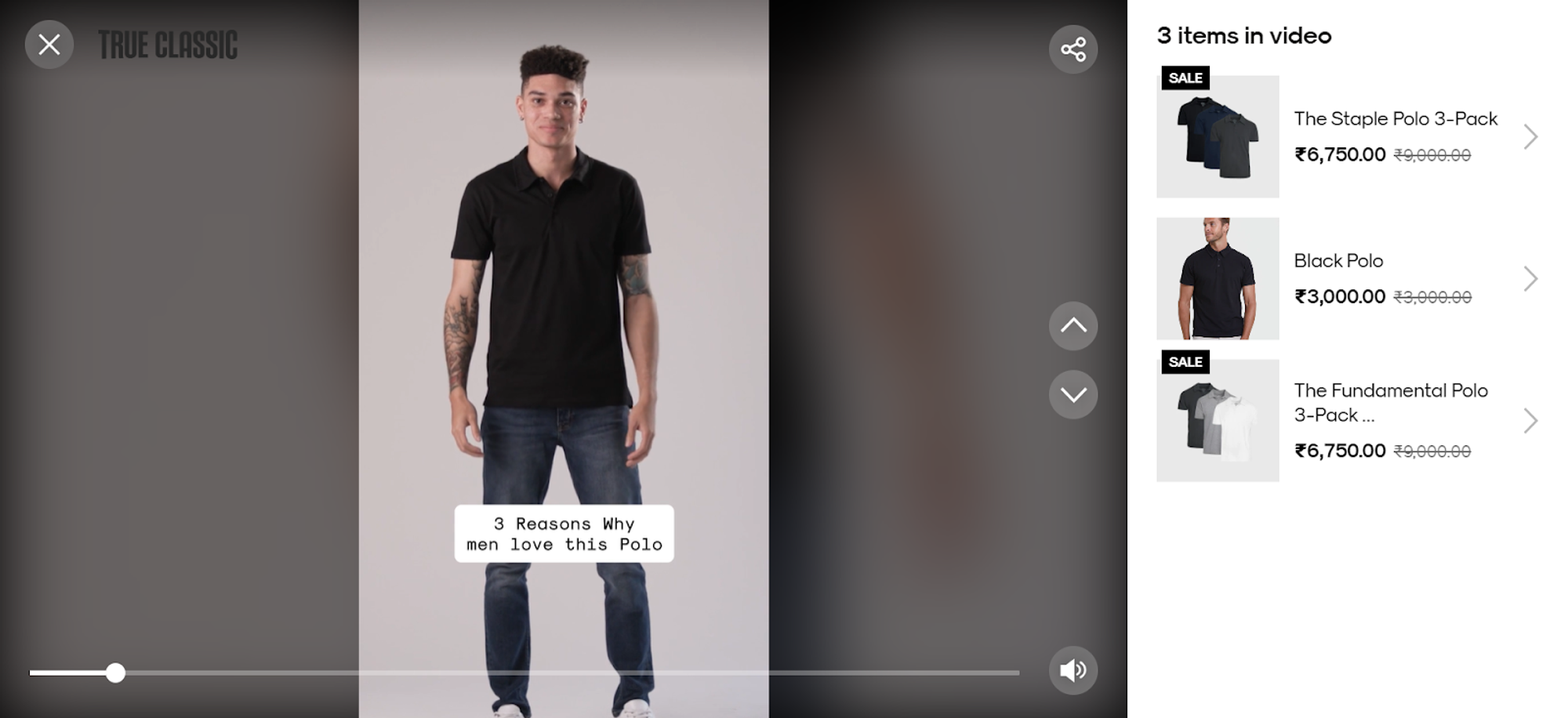Share
Creating stellar videos takes time, resources, and a lot of creative effort. It can be a tedious and tiring process.
But the real struggle is when these videos fail to drive sales, and you can’t figure out why.
We know how frustrating it can be to pour your heart and soul into creating amazing videos only for shoppers to click away without even watching them until the end.
So, here’s the silver lining: we created this in-depth guide covering seven advanced tactics for optimizing video conversion rates. With this guide, we’ll help you create a better video optimization strategy to unlock higher conversion rates.
7 proven tactics to maximize video conversion rate
Ready to win with video marketing? We’ve curated seven best practices to help you get the best out of video content and increase your conversion rate. Let’s break them down.
1. Analyzing your current conversion funnel
Before strategizing ways to optimize your video conversion rates, you need to establish a baseline to plan your efforts and track progress. So, start with an in-depth analysis of your conversion funnel to define where you currently stand.
Look at key metrics like the number of impressions on your videos, average click-through rate (CTR), engagement rate, and direct revenue from video. This initial assessment will:
-
Reveal bottlenecks hurting your existing video marketing strategy
-
Set the stage for future success by addressing the gaps in your funnel
When you know exactly where to improve, you can allocate resources strategically and maximize ROI even with a tight budget. For example, if you're driving more leads/sales from channel A while channel B has only been mildly successful, you can double down on channel A and put the latter on hold.
Bonus: by analyzing your conversion funnel, you can gain a deeper understanding of your shoppers. This analysis will give you a clearer picture of the typical buyer journey and how buyers interact with your videos.
Here’s an example of how analyzing your conversion funnel can help in targeting the right channels:
2. Leveraging personalization in video content
Savvy shoppers today expect more from eCommerce brands. They want to feel connected with your brand and share a level of trust before they can buy from you. That’s exactly where personalization can work wonders.
But gone are the days when brands could send a name-tagged email and call it personalization. You have to go deeper to capture shoppers’ attention and win their trust.
With personalization in video marketing, you can engage your audience and deliver a frictionless experience from discovery to purchase. So, how exactly can you leverage personalization to level up your video marketing strategy? Here are a few tried-and-tested tips:
-
Run ads based on browsing behavior and individual preferences/actions (like visiting your website).
-
Create interactive videos to let every shopper choose their own adventure and explore your products
-
Localize videos as per language and cultural references to resonate more with local buyers
-
Segment shoppers based on their past purchases or actions and send target video emails
-
Leverage personalization with user-generated content to influence shoppers organically
Here's an example: Aimee, the CEO of Sculped by Aimee, created a personalized video quiz to engage and educate the audience interactively and dynamically. She’s offering her clients a straightforward way to access the information they need and shop directly without wasting time searching, scrolling, or researching.

3. Implementing interactive elements
With so many apps vying for shoppers' attention, it's getting harder for eCommerce brands to stand out. Your video content will only add to this noise unless you create something exceptional.
But you can capture their attention and reel them in with interactive videos. Adding interactive elements in videos, like polls, clickable hotspots, quizzes, and product links, can create a more immersive experience for your audience. You can also personalize this experience by creating conditional paths within the video to let viewers choose their adventure.
Besides engaging shoppers, interactive videos can boost your lead generation efforts and drive conversions consistently. Here’s how:
-
Collect customer data: You can collect in-depth data about customer preferences and the buyer journey by analyzing how viewers interact with these videos. Check how long they watched the video, where they dropped off, and what products they were interested in.
-
Higher information retention: When viewers can play around with the interactive elements in a video, they get more involved in the content. This helps them retain the message better and recall your brand in the future.
-
Optimize the CTA: Interactive videos let you add an immediate call to action within your content. Unlike other videos where CTAs are added outside the video, interactive videos encourage viewers to instantly click and take the desired action.
-
Direct path to purchase: Interactive videos can increase conversion rates because they shorten the path to purchase. For example, a user coming across your brand for the first time can check out a shoppable video and learn more about your product. If they like what they see, they can immediately place an order.
Take a page out of Dr. Dennis Gross’s book. The skincare brand leveraged interactive video quizzes and shoppable videos to drive engagement among its audience. They also converted user-generated content into interactive videos with an option to get more details about the product and buy it immediately.
The result? People watched 75% of their videos on average, and the brand received 5,000 orders directly attributed to these interactive videos. Here’s a snippet of shoppable videos embedded on their website:
.png?width=2000&height=938&name=image%20(4).png)
The bottom line is that interactive videos keep viewers hooked longer and reduce drop-offs. People are more invested in your message and likely to explore your store or buy something.
4. A/B testing for video optimization
Picture this: you’ve created the best possible videos for a new campaign. But a month since its launch, the campaign has only produced a disappointing conversion rate. You’re left scratching your head and wondering what you could’ve done differently.
The short answer: conduct A/B testing.
A/B testing is analyzing two (or more) versions of any content to identify which would resonate more with a specific audience. So, instead of relying on guesswork about what you think your shoppers will like, you can create data-backed content optimized for their preferences.
With videos, you can perform A/B testing for different elements, such as:
-
Color palette
-
Narrative style
-
Video thumbnail
-
Main call to action
-
Length and messaging
-
Text and transition effects
These are just a few of the many parameters to consider when running an A/B test for videos. For these tests to be successful, you must first develop a few hypotheses of what your shoppers would like.
Once you've narrowed their preferences, you can create (or modify) your videos to best match these expectations. For example, if most of your shoppers like quirky messaging and short-form videos, you can compare two videos with different tonalities and lengths.
Besides optimizing videos, you can also split-test their placement and copy. These A/B tests can help you decide the best position for your content on any channel, supported by compelling copy.
5. Nurturing leads with video email marketing
Email continues to be one of the most impactful channels for eCommerce businesses to attract, engage, and convert shoppers.
But imagine the results you could achieve by combining the power of your email campaigns with videos specifically created for your audience. Sounds fantastic, right?
Sackcloth & Ashes introduced a new product line with this video email. Instead of simply telling customers about the new collection, the brand embedded a video in the email to give them a glimpse of the products.
We've curated these actionable tips to turn email marketing into a high-impact lead-nurturing channel:
-
Create multiple videos for different types of buyer intent and levels of interest in your brand
-
Embed video thumbnails in your emails or add shoppable videos for a one-click checkout
-
Optimize these videos for mobile screens since most shoppers view emails on mobile
-
Add a clear CTA to all videos in your emails to guide readers about the next steps
You can also personalize these emails using behavioral triggers. For example, if a shopper clicks on a product ad and checks out the page but doesn't place an order, you can send them an email with a shoppable video showing the product in a 360-degree view.
Remember to optimize your video loading speed to remove the hassle of long wait times for watchers.
6. Enhancing video SEO and discoverability
Search engine optimization (SEO) is a critical piece of the puzzle to increase visibility for your videos and drive organic traffic.
When investing so much time and resources into your video marketing strategy, go the extra mile to optimize this content for search engines and bring more shoppers into your conversion funnel.
Here’s a checklist of advanced SEO tactics to improve the discoverability of your videos:
-
Keyword research: Find long-tail keywords relevant to each video and include these keywords in the right places, like the title, description, video file name, etc. Long-tail keywords essentially refer to a longer string of words people use to find specific results—like "organic food options for a high-anxiety dog."
-
Inline embedding: Using inline embeds, you can directly integrate videos into your website pages. This makes your videos crawlable and enables search engines to recognize the rich content. These embedded videos also improve the user experience since visitors don't have to go to external links to watch the video.
-
Optimize page speed: Page speed is a ranking factor for several search engines. Slowly loading videos can hurt your site speed and lower your SEO capabilities. Use tools like Videowise to maintain the optimal page speed and load videos quickly to win higher rankings.
-
Video sitemap and schema: Search engines can check all the metadata for your videos with a sitemap. This allows them to understand each video's context and index the content quickly. As a result, your videos will appear for the most relevant search queries. At the same time, a schema markup increases your chances of featuring in rich snippet search results.
Brands like True Classic present a great case study on optimizing videos for search. The men’s wear brand has embedded videos across 700 product pages, each video tailored to the product. They used a powerful video eCommerce platform like Videowise to embed all these videos in bulk and save hours of manual effort.
More importantly, True Classic achieved a much faster page speed for these videos with Videowise’s lazy-loaded video widgets, compressed assets, small .JS scripts, and adaptive bitrate streaming.
The result? Shoppers watched 70% of videos on average, and True Classic’s video conversion rates soared to 13%.
7. Optimizing landing pages for video conversions
The last one of our seven best practices to boost your video conversion rate is creating a stellar landing page. When potential customers land on your page, they should be motivated to explore and watch your video. That’s when your content can truly work its magic and nudge them to a buying decision.
But how do you create high-converting landing pages with video content? Here are a few considerations before you launch your page:
-
Define the goal of your landing page—whether it’s driving awareness, bringing sign-ups, or getting more sales
-
Design a functional page layout to create a frictionless user experience and strategically choose your video’s placement
-
Write convincing copy and conduct A/B tests for different elements, like the hero header, CTA copy, and value propositions
-
Test your landing page from multiple angles, like functionality, messaging, visual appeal, clarity, and loading speed
Eczema Honey presents a wonderful example of a conversion-optimized video landing page. While the page offers basic product details above the fold, you can see a collection of user-generated videos embedded right under the hero section.
These UG videos offer social proof for the brand and show potential customers how to use the product—win-win! But the best part is that each video is in the shoppable format. So, users can watch videos and instantly place an order instead of a longer checkout process.
Strategically incorporating videos in their product pages has helped Eczema Honey boost their conversion rate by 1% and increase their average order value as well.

Don’t forget to measure success and iterate
You’ve done all the hard work to create, optimize, and distribute your videos. What’s next? Measuring performance and shifting gears to improve the ROI.
Revisit the first step and look at your baseline. Then, analyze progress based on your current performance metrics. Here are a few crucial KPIs to consider for video conversion optimization:
-
Number of views or impressions
-
Play rate and completion rate
-
Average watch time
-
Click-through rate
-
Engagement rate
-
Social shares
-
Bounce rate
These metrics will give you an overall idea of how your videos have impacted shoppers. Spend some extra time analyzing this data to identify gaps and opportunities in your strategy. You can then use this analysis to iterate your plan of action and optimize your campaign.
You’re ready to boost conversion rates with video
That’s a wrap! We’ve covered seven advanced tactics to win with videos and maximize revenue. Bookmark this guide to refer to these best practices and follow the examples we’ve shared.
Remember to start by assessing your current conversion funnel and work your way from there. You should also focus on implementing these tactics one at a time instead of going all in. Strategically invest your time and resources to make every campaign a success.
Read our collection of success stories if you need more inspiration. You can also watch advanced tutorials to level up your video marketing efforts.
Share


-1.png?width=495&height=376&name=image%20(3)-1.png)
.png?width=2000&height=1334&name=image%20(5).png)
.png?width=453&height=800&name=image%20(6).png)



.jpg?width=420&height=420&name=live%20shopping%20top%205%20fashion%20(1).jpg)